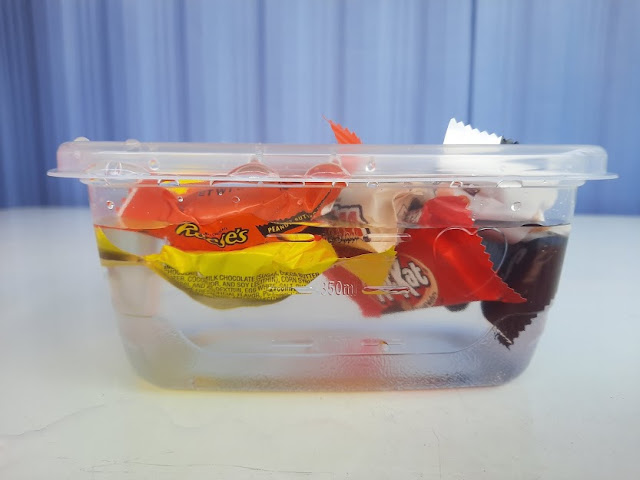It's only September and the stores are already gearing up for Halloween. Shelf after shelf after shelf is loaded up with bags of Halloween candy waiting for you to buy it and take it home. Of course, we can eat the Halloween candy or pass it out to trick-or-treaters, but we can also use it to teach little ones about one of the basic fundamentals of science... does it sink or float?
Disclosure:
Affiliate links
to Amazon are included in this post.
It's never too early to introduce science to children in a fun manner. You can use this simple science experiment to introduce new vocabulary words to your little learners:
- sink
- float
- predict
- result
- material
- procedure

Even though this experiment is intended for our young learners, children
of all ages may enjoy giving it a try. Science is always fun...
especially when Halloween candy is involved! If you try this
experiment with older children, you can introduce them to more
sophisticated science concepts:
- scientific process / method
- trial and error
- variables
- observe / observation

Materials Needed
There are only a few items needed for this experiment.
- 10 pieces of wrapped candy
- bowl of water
- pen or pencil
- sink or float record sheet (optional)
Procedure
The procedure for this science experiment is not complicated at all.
Students simply drop the Halloween candy into the bowl one at a time,
observe whether or not it sinks, and record the results. Not so bad,
right?
It'd be negligent of me if I didn't say something at this point.
Even though this is a fun and easy science experiment for kids, conducting
this science experiment without any kind of focus lesson or review will
keep the children entertained for a few minutes, but won't teach them much
of anything. Use this science experiment as a means to introduce and
reinforce the objectives you need to teach.
(Unless... you are using this as a party game at a Halloween party.
If that's the case... have at it and worry about the science concepts
later!)

Record the Results
If you choose to use my premade sink or float worksheet, there are no hard
and fast directions about how to fill it out. Three of the most
commonly used ways are:
- The children can fill out all of the boxes on their own using words, phrases, sentences, or drawings.
- The children can glue the pieces of candy in the first column and fill in the second column.
- The children can eat the candy, glue the empty wrappers in the first column, then fill out the second column!
To download a FREE copy of this science experiment worksheet, click on the
image above. Clicking on this image will take you to the Teachers-Pay-Teachers
third-party website. This is a
FREE download-- no purchase necessary.
Extend Your Learning
While doing this experiment, you may discover that the majority of wrapped chocolate candies will float. This is because of the air in the wrappers. Try the experiment again, but use unwrapped candy this time. How did unwrapping the candy change the results?
(Next Article:
How to Make a Paper Bag Pumpkin)



